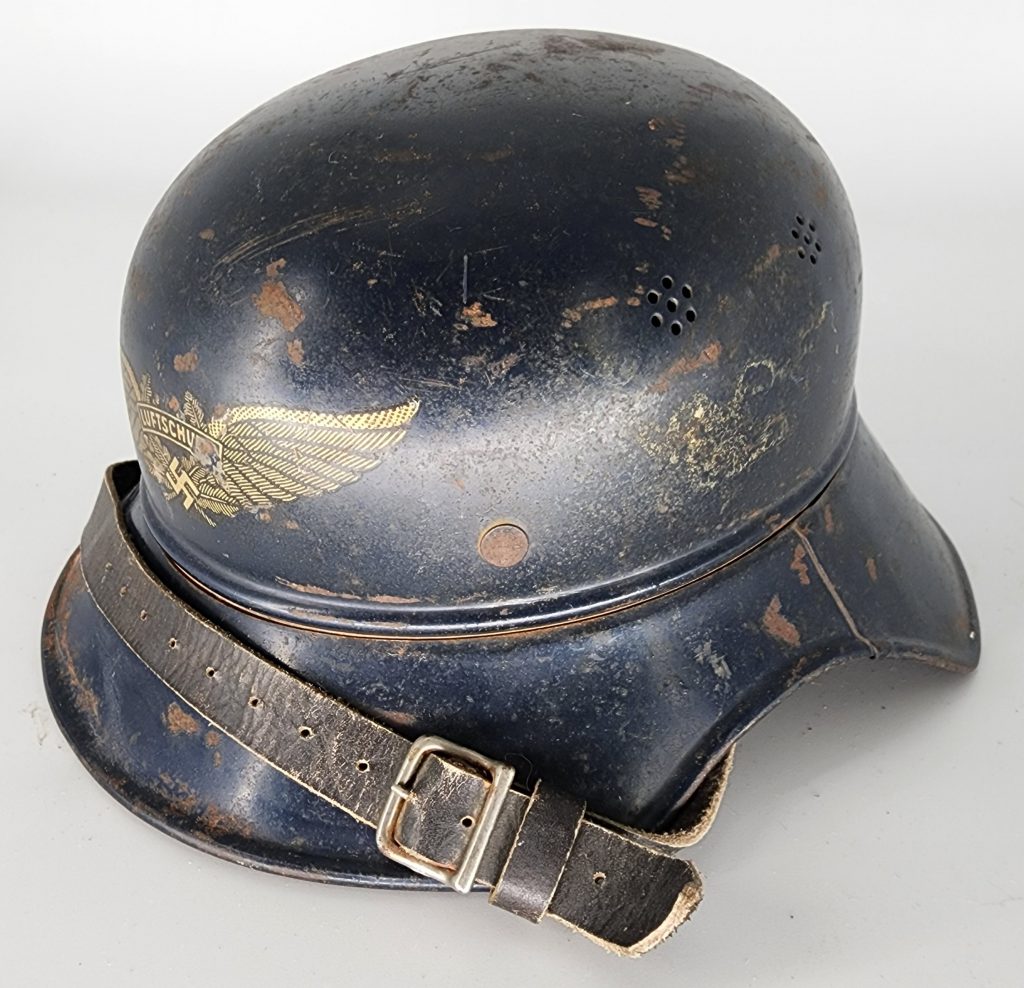Between 1933 and 1945, the Germans used many different styles and configurations of helmets. From leftover WWI helmets, non-combat helmets, three different designs of WWII combat helmets and decals denoting each branch of service, there are hundreds if not thousands of different WWII German helmets that can be encountered.
WWII German Transitional Helmet. At the end of WWI it is estimated that Germany had produced about 8,500,000 steel helmets, and though they saw widespread use by Freikorps personnel, there was still a stockpile controlled by the Reichswehr. Although helmet development was ongoing when Hitler came to power in 1933, the M16 and M18 helmets were still the main headgear worn by the Reichswehr. The helmets remained the same until March 1933 when the provincial shields were discontinued in favor of the national tri-color shield. In 1934 the national eagle shield was introduced, and both the tri-color and eagle shields were applied to the helmets. After the development of the new M35 helmet , the WWI helmets were still issued by second line and training troops well into WWII. This example is a Luftwaffe helmet due to flying eagle on the side.
Special Note: This helmet was acquired through one of many trades from Joe Santucci who passed away in 2020. He was a fellow collector, MAX Show Life Member and good friend. It is one of the most treasured items in our collection. It was also featured on an episode of America Pickers that can be seen HERE.

The WWII German M35 Helmet was tested and designed in 1934 to improve on the M18 model of WWI and introduced in 1935. The size of the flared visor and skirt was reduced, and the large projecting lugs for the obsolete armour shield were eliminated. The ventilator holes were retained but were set in smaller hollow rivets mounted to the helmet’s shell. The edges of the shell were rolled over, creating a smooth edge along the helmet. Finally, a completely new leather suspension, or liner, was incorporated that greatly improved the helmet’s safety, adjustability, and comfort for each wearer. These improvements made the new M35 helmet lighter, more compact, and more comfortable to wear than the WWI designs. Each branch of the military (army, air force, navy, police and SS) utilized the same shell, but differentiated itself by the insignia applied to the helmet. Early on, before WWII started, the helmets had a more parade type finish and a national decal on the opposite side of the branch decal. This example is an Army helmet due to the silver eagle decal on the side.

The WWII German M40 Helmet was introduced in 1940 to simplify the helmet’s construction. The manufacturing process now incorporated more automated stamping methods. The principal visual change was to stamp the ventilator hole mounts directly onto the shell, rather than utilizing separate fittings. This example is a Navy / Kriegsmarine helmet due to the gold eagle on the side. The gold Kriegsmarine decals often look orange in color due to age.

WWII German M38 Paratrooper Helmet. A variant of the M35 helmet with a shell lacking the projecting visor and deep flared rim was issued to Fallschirmjäger (WWII German Paratrooper Helmet) units (M38). It also utilized a more protective liner and 4 point harness chinstrap system. It was designed in order to lessen the risk of head injury on landing after a parachute jump and to reduce the significant wind resistance and resulting neck trauma. This example is a single decal Luftwaffe helmet.

The WWII German M42 Helmet design was a result of wartime demands. In 1942 from direct orders from the Führer, to reduce the cos’, the rolled edge on the shell was eliminated. The elimination of the rolled edge expedited the manufacturing process and reduced the amount of metal used in each helmet. Shell paint colors were typically matte grey-green (Heer) or grey-blue (Luftwaffe), and all decals were to be eliminated in 1943 to speed up production and reduce the helmet’s combat visibility. This example is an SS helmet. Note, the SS chose to put their branch of service decal is on the right side and not the left as with all the other branches.

The Germans also implemented lighter weight helmets to be used for non combat situations such as air raid, civil police and fire personnel. This example is a Luftschutz Helmet. This branches duties were similar to those of the Civil Defense in the U.S.

